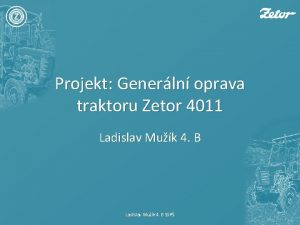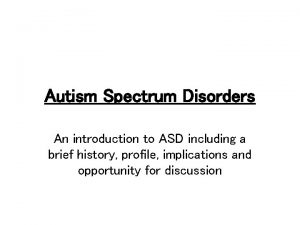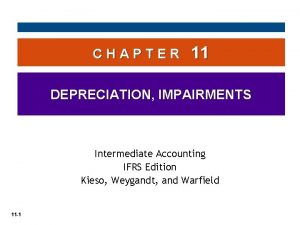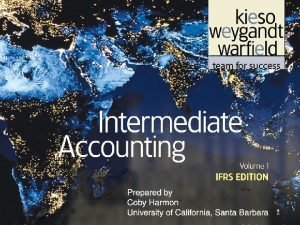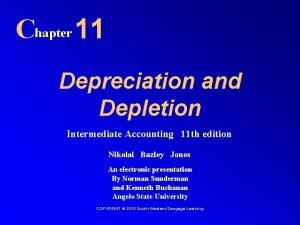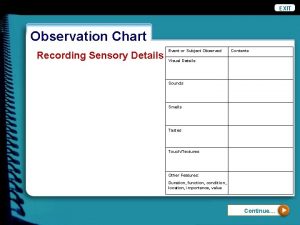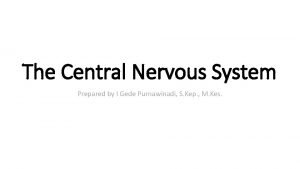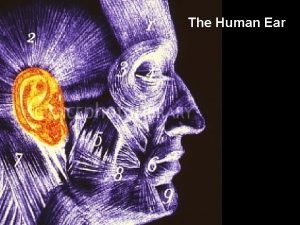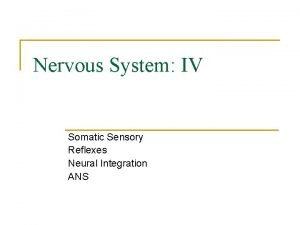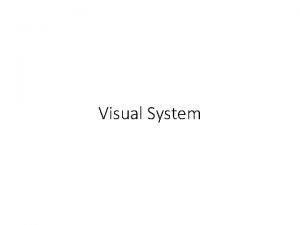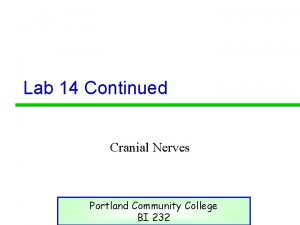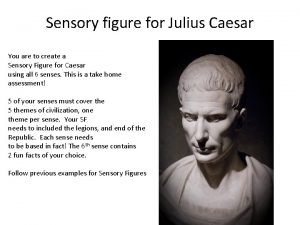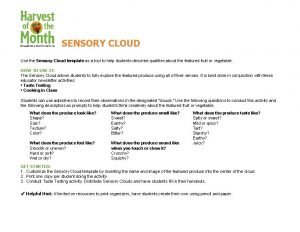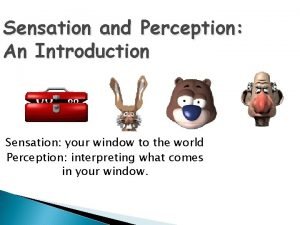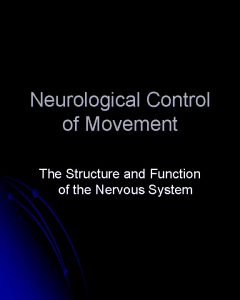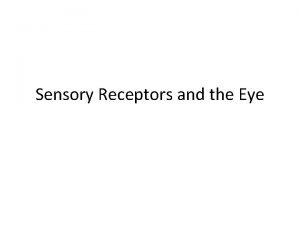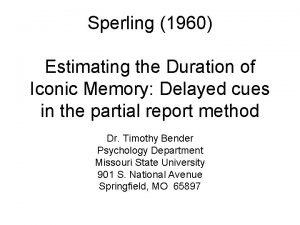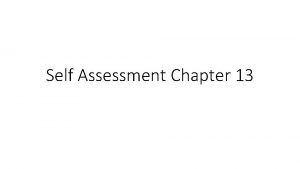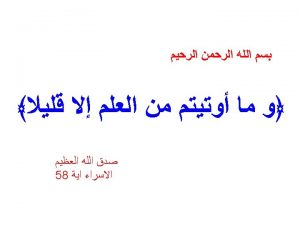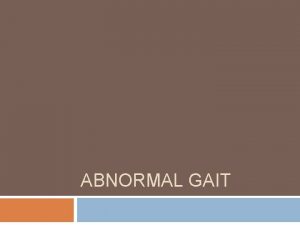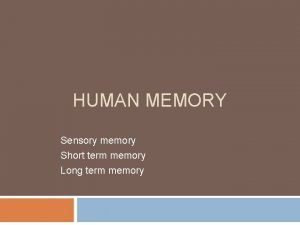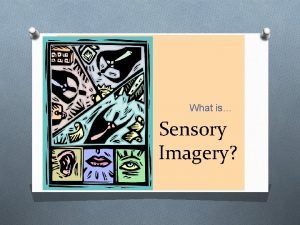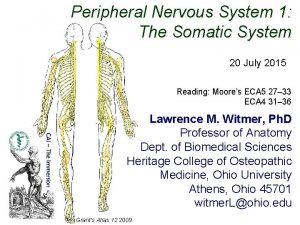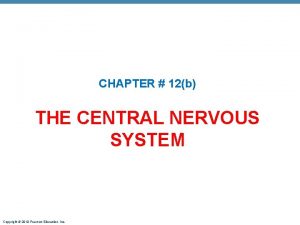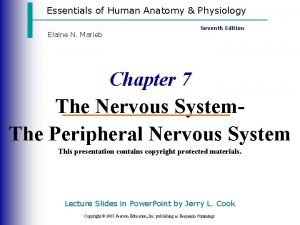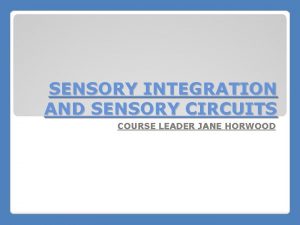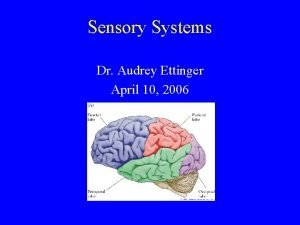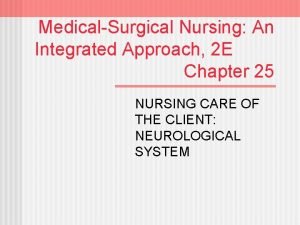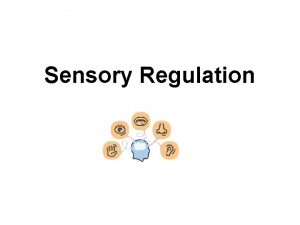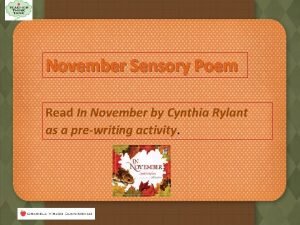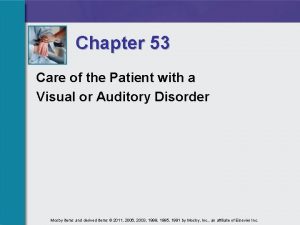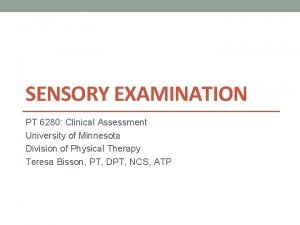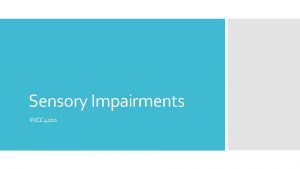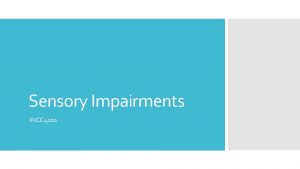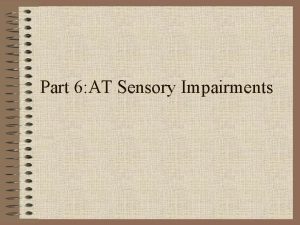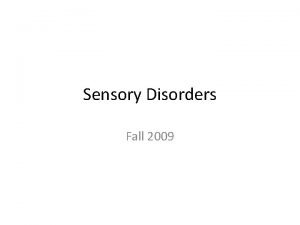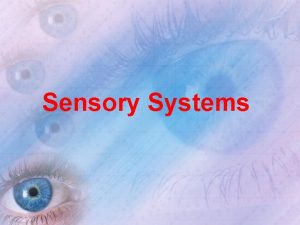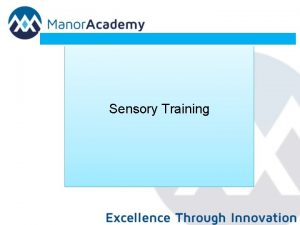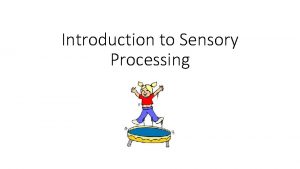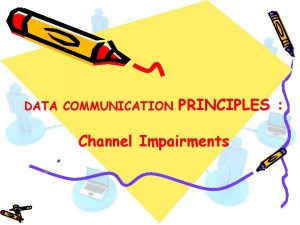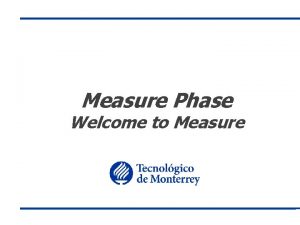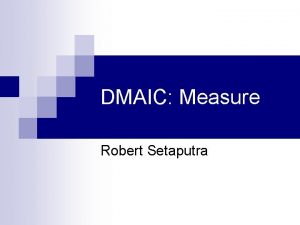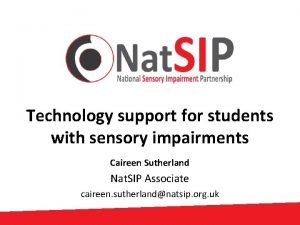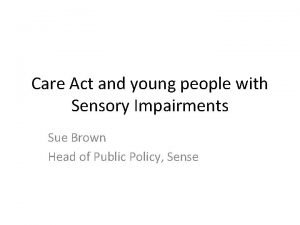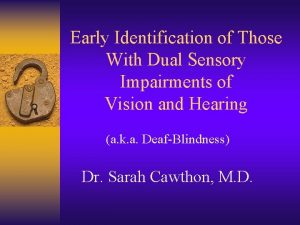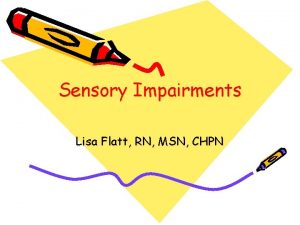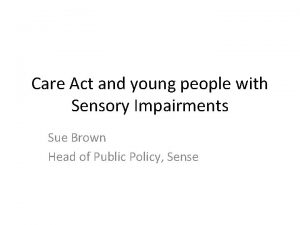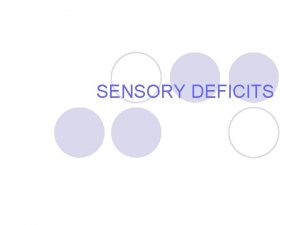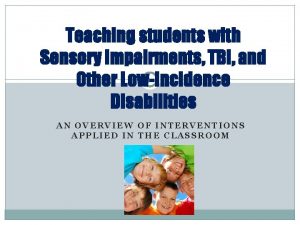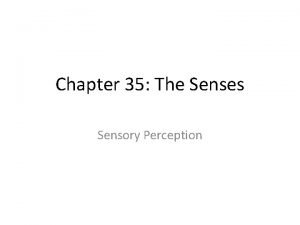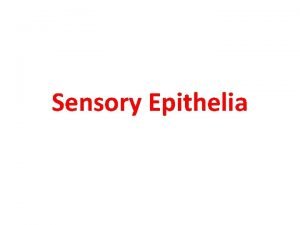Sensory Impairments INCC 4011 How do we measure













































- Slides: 45

Sensory Impairments INCC 4011

How do we measure hearing?

Catorgarising Hearning Loss

What can you hear with mild to moderate hearing loss?

Experience Hearing Loss with the Flintstones Experience Hearing Loss

Mild Hearing Loss huge impact

Types and causes Hearing Loss Conductive- a “blockage" along the pathway of sound. This could be in the outer ear – lots of wax, a perforated ear drum OR in the middle ear e. g. glue ear Sensori- neural – damage to the inner ear or beyond. This could be damage to the hair cells in the inner ear OR damage along the nerve fibres to the brain Mixed - Conductive hearing loss is the most common

Glue Ear

Is a build up of sticky fluid in the middle ear May cause pain Glue ear Four out of five children will experience it to some degree at some point. Although not usually serious in itself it can cause long term difficulties in other areas of development Hearing loss may come and go



Cochlea Implants https: //www. youtube. com/watch? v=2 rh. Ro 73 F 324

What the figures show Early Years Foundation Stage NDCS note on Department for Education figures on attainment for deaf children in 2017 (England) Updated: 25 January 2018 In 2017, 34% of deaf children were recorded as having achieved a “good level of development” in the early years, compared to 76% of children with no identified SEN. The proportion of deaf children reaching this level has increased from 32% in 2016. It remains of concern that around two thirds of deaf children arrive at primary school having not achieved a good level of development in the early years. Writing, reading and speaking remain the most challenging of the 17 early learning goals for deaf children – with less than half of deaf children reaching the expected standard in each of these goals.

Key Stage 1 What the figures show Deaf children’s attainment at Key Stage 1 has increased across all measures. However, around half of deaf children still failed to achieve the expected standard at Key Stage 1 for reading (49%) and maths (49%) NDCS note on Department for Education figures on attainment for deaf children in 2017 (England) Updated: 25 January 2018

What the figures show Key Stage 2 NDCS note on Department for Education figures on attainment for deaf children in 2017 (England) Updated: 25 January 2018 61% of deaf children are leaving primary school having failed to achieve the expected standard at reading, writing and mathematics compared to 30% of children with no identified SEN. Deaf children fall behind as they progress through primary school, compared to their peers of the same ability – their progress score on reading is minus 1. 1 compared to +0. 3 for children with no identified SEN.

Delayed speech. Mild Hearing Loss Signs to look out for Mishearing and mispronouncing words. Not hearing what's going on if there's background noise. Problems with concentrating, tiredness and frustration that affects their behaviour. Preferring to play alone. Difficulties with reading and learning. Wanting the volume of the TV higher than other members of your family.

A delay in learning to speak Impact of hearing loss Expressive Language Verb tenses incorrect Unclear speech Shouting or talking over loudly Speaking very softly

Missing or misunderstanding little words in speech (in, on etc) Impact of hearing loss Comprehension Difficulty with listening and attention Say pardon, eh, what. Not “ear-wigging”!

Impact of hearing loss Behaviour Not responding when you call or use their name Not following instructions Reluctant to join in Temper tantrums or disruptive behaviour Becoming withdrawn Continuing with an activity when others have stopped Inattentive and “daydreaming”

Constantly asking for repetition, pardon, what, eh. Impact of hearing loss Self help skills Watching others before doing it themselves Watching face or lips intently Attempting to control conversation by talking Frequently asking for help from friends

A deaf adult says … “Many people don’t realise how exhausting listening, concentrating, filling in gaps, guessing the subject, and deciphering body language, lip patterns and facial expressions, is. ” – Deaf adult

Before you speak • Get the child’s attention before speaking • Do not give too many instructions at once How to support children with hearing loss When you are speaking • Talk normally try not to exaggerate lip movements • Use lots of visual clues, demonstrate where possible • Repeat key words Environment • Sit the child at a suitable distance away from you • Reduce background noise • Make sure the room is well lit and don’t stand with your back to a window • Get down to their level to speak

Hear to Learn Good communication Adapting resources

Find a lesson plan (either one of your own or from TES or Twinkle Inclusive Planning Where might you need to make adjustments for a child with a hearing loss What will the teacher have to be aware of while teaching the lesson.

Specialist support Teacher of the Deaf Read about this specialist teacher role and watch the videos of interviews with qualified teachers of the deaf

BSL Total Communication Cued Speech Natural Auditory Verbal BSL used exclusively Right to sign Communication methods Flexible use of multiple methods –e. g. signing, lip reading, finger spelling, gesture. Used in whatever combination works for the child Hand gestures draw attention to and support spoken words, each sound is signed near the mouth Cued Articulation Natural Aural – Listening and talking is emphasised in the natural environment (i. e. not taught). This is the most commonly used approach by Teachers of the Deaf Auditory Verbal – a specific listening and speaking approach delivered by licenced teachers not common in the UK

https: //www. theguardian. com/science/2014/mar/16/bionic-earscochlear-implants-transformed-lives-children More resources to look at Hear to Help Videos Join the National Deaf Childrens’ Society – its free. Download – Communicating with Your Deaf Child.

The Silent Child This film won Oscars a couple of years ago and was highly acclaimed by the deaf community Unfortunately it costs a small amount to download but please try to watch it if you can. It last 20 minutes

Visual impairment A visual impairment is vision which can not be fully corrected by the wearing of glasses.

Identifying children with sight loss Red or watery eyes Eyes in constant motion Finding tasks unusually tiring Poor hand eye co-ordination Unusual head posture Sensitivity to light Bending closely over work Lots of blinking, squinting, rubbing eyes

1. Low acuity – sharpness of image, can be near or distance or both 2. Central vision loss – can move around relatively easily but close tasks such as reading can be difficult 3. Types of sight loss Peripheral vision loss – good central vision meaning close work can be possible but moving around is difficult 4. Patchy vision – means scanning to build up the whole picture, complicated visual tasks can be hard 5. Low contrast sensitivity – hard to pick out things that are close in shade or colour. Can be hard in some environments 6. Eye movement difficulty – for example Nystagmus, where the eye is constantly moving, makes tracking difficult 7. Colour Blindness – not considered a sight loss but can accompany other conditions

What do you need to know about a child’s sightloss courtesy of the RNIB - Access to Education Is their sight stable or is it variable? If so, under what conditions? What is the extent of their effective distance vision, for example, for reading from the whiteboard? What size and style of print can they read comfortably? Is their field of vision normal or restricted? For example, is peripheral vision reduced or areas within the visual field missing? How does this affect their ability to work with diagrams, maps, etc? Is there a limited time over which the learner is able to use their sight efficiently before their eyes become tired? How competent are they in moving around the classroom independently and safely? Do they have particular preferences regarding the classroom environment, such as the nature of the lighting, seating position, or the use of the whiteboard?

How much sight, if any, do they have? How useful is it and for what activities? What do you need to know about a child who is blind? What level of skill do they possess in braille and other tactile skills? In particular, what is their speed of reading? What experience of the visual world, if any, do they have? Have they ever seen and therefore possess any visual memory? Do they tire easily? Is there a limited period of time over which they can work efficiently? How competent are they in moving around the classroom independently and safely?


What can you do to support? Sit child near to and facing the front Ensure good levels of lighting whilst avoiding glare. Use the child’s name Use pens which provide a good contrast when writing for the child Allow longer for examining resources or demonstrations Don’t ask the child “can you see that? ” No one knows what they cannot see.

Inclusive environments Signage – clear, well positioned and easily visible, perhaps using braille or symbol. Steps, edges, pillars and other transition points highlighted with yellow paint. Handrails to help with mobility. ‘Tactile trails’ – dado rails or other textured materials at hand height, that learners can follow to find the route to a particular location in school − eg toilets, dining hall. Different floor coverings for different areas of the school to indicate a change of environment. Clear panels on doors so people can be seen approaching from the other side. A distinction between quiet and active areas in the playground, and shaded areas for learners with light sensitivity. Sensory gardens. Courtesy of the RNIB Well-maintained grounds, free of obstructions. Corridors, cloakrooms and classrooms kept free of obstructions.

Avoid standing in front of windows - this can reduce you to a silhouette and make it difficult for all learners to see you properly. Teaching Position Learners who have VI need to sit in the best position to see the whiteboard, etc, but not separately from the other learners. Do learners with vision impairment need to sit close to a power source if they are using ICT devices?

Garry’s Visualiser

Garry’s Visualiser with book

Garry’s visualiser with book … and Garry!

ipads Explore the accessibility features available on the ipads

They may have difficulty in observing and imitating their peers which can impact on the development of age appropriate behaviours. A child may miss out on some of the visual clues and body language that people use to establish friendships. Social Inclusion They may be more dependent on their parents in many areas, which may adversely affect the development of a sense of independence, one of the most important factors in relation to their self esteem and adjustment. They may experience greater feelings of failure, particularly in relation to sport and exercise. They may be less accepted by their peer group and have fewer friends which is likely to impact on their self esteem.

Teaching and learning resources Are the print resources you use in an appropriate format for learners? (Consider print size, font and contrast. When working with vision impaired learners you should take advice from the learner, their parents/carers, the Special Educational Needs Coordinator (SENCO) or the QTVI, as appropriate. Do learners have a good reading position? (Reading stands or raised boards are useful to help some learners get the best reading position. ) Do you use real objects and artefacts to support your teaching? Do learners who use special equipment or large print resources have adequate space to work?

Wikkistix Challenge Can we make a tactile world map with wikkistix?

Blind School Radio 4 Drama https: //www. bbc. co. uk/sounds/play/p 06 zy 5 h 1
 Zetor 4011 hmotnost
Zetor 4011 hmotnost Define the modifiers of human acts
Define the modifiers of human acts Wings triad
Wings triad Kunci jawaban buku intermediate accounting ifrs chapter 11
Kunci jawaban buku intermediate accounting ifrs chapter 11 What is the difference between depreciation and impairment
What is the difference between depreciation and impairment Chapter 11 depreciation impairments and depletion
Chapter 11 depreciation impairments and depletion Uses of wind vane
Uses of wind vane Gibbons jacobean city comedy download
Gibbons jacobean city comedy download Sensory details chart
Sensory details chart Classification of nervous system
Classification of nervous system Pathway
Pathway Fluid that bathes the sensory receptors of the inner ear
Fluid that bathes the sensory receptors of the inner ear Sensory processing disorder dsm
Sensory processing disorder dsm Location of sensory neurons
Location of sensory neurons Sensory stimulation theory
Sensory stimulation theory Sensory transduction
Sensory transduction Hypoglossal nerve test
Hypoglossal nerve test Sensory figure
Sensory figure Sensory cloud
Sensory cloud Habituation psychology
Habituation psychology Nerve supply of external ear
Nerve supply of external ear Sensory-motor
Sensory-motor Sensory receptors in eye
Sensory receptors in eye Trigrams for replican of peterson and peterson
Trigrams for replican of peterson and peterson Sperling iconic memory
Sperling iconic memory The hot july sun beat relentlessly down
The hot july sun beat relentlessly down Referred pain chart female
Referred pain chart female On old olympus towering tops a friendly viking
On old olympus towering tops a friendly viking Primary somatic sensory
Primary somatic sensory Types of gait
Types of gait Sensory memory example
Sensory memory example Termite communication
Termite communication Causes of food deterioration
Causes of food deterioration Sight imagery examples
Sight imagery examples Sensory evaluation
Sensory evaluation Erb palsy
Erb palsy Copyright
Copyright Cranial nerve number face
Cranial nerve number face Sensory symptoms
Sensory symptoms Characteristics of sensory neurons
Characteristics of sensory neurons Sensory ethnography
Sensory ethnography Cranial nerves sensory and motor
Cranial nerves sensory and motor Sensory cup analogy
Sensory cup analogy Sensory poem generator
Sensory poem generator Chapter 53 care of the patient with a sensory disorder
Chapter 53 care of the patient with a sensory disorder Sensory coding
Sensory coding
